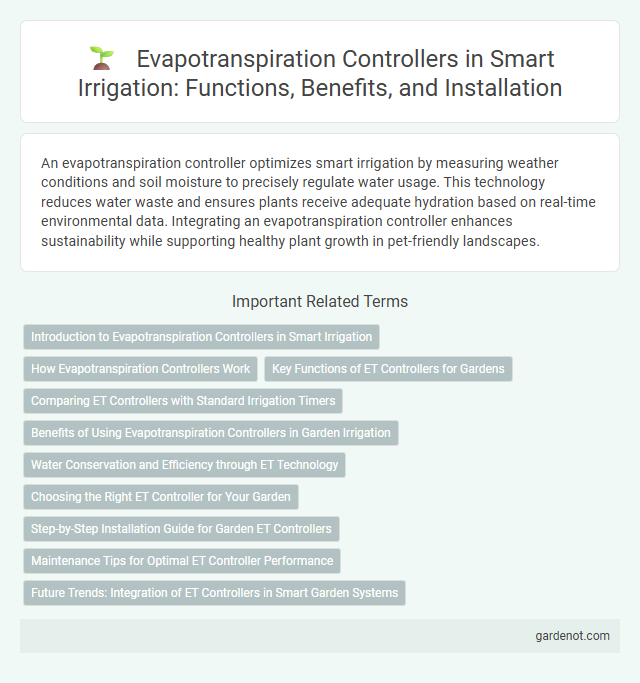An evapotranspiration controller optimizes smart irrigation by measuring weather conditions and soil moisture to precisely regulate water usage. This technology reduces water waste and ensures plants receive adequate hydration based on real-time environmental data. Integrating an evapotranspiration controller enhances sustainability while supporting healthy plant growth in pet-friendly landscapes.
Introduction to Evapotranspiration Controllers in Smart Irrigation
Evapotranspiration controllers optimize water usage by adjusting irrigation schedules based on real-time weather data, plant needs, and soil moisture levels. These advanced devices measure evapotranspiration rates to ensure precise water delivery, reducing waste and promoting sustainable landscape management. Integrating evapotranspiration controllers within smart irrigation systems enhances drought resilience and supports efficient resource conservation.
How Evapotranspiration Controllers Work
Evapotranspiration controllers operate by calculating the water loss from soil and plants through evaporation and transpiration using local weather data, including temperature, humidity, solar radiation, and wind speed. These controllers adjust irrigation schedules dynamically, ensuring plants receive precise water amounts tailored to current environmental conditions. By optimizing water use, evapotranspiration controllers help reduce water waste while maintaining healthy plant growth.
Key Functions of ET Controllers for Gardens
Evapotranspiration (ET) controllers optimize garden irrigation by calculating water loss through plant transpiration and soil evaporation using real-time weather data, ensuring precise hydration. These controllers adjust watering schedules based on factors like temperature, humidity, solar radiation, and wind speed, significantly reducing water waste. Integration with soil moisture sensors and weather stations enhances the efficiency of ET controllers, promoting healthy plant growth and sustainable water management in gardens.
Comparing ET Controllers with Standard Irrigation Timers
Evapotranspiration (ET) controllers optimize water usage by adjusting irrigation schedules based on real-time weather data, soil moisture, and plant water needs, significantly reducing water waste compared to standard irrigation timers. Unlike fixed-duration timers that operate on preset schedules without considering environmental conditions, ET controllers enhance water efficiency by dynamically modifying run times to reflect evapotranspiration rates. Studies show ET controllers can reduce water consumption by up to 30%, improving sustainability for agricultural and landscape irrigation.
Benefits of Using Evapotranspiration Controllers in Garden Irrigation
Evapotranspiration controllers optimize garden irrigation by adjusting watering schedules based on real-time weather data, reducing water waste and promoting efficient water usage. These controllers enhance plant health by providing precise moisture levels tailored to specific vegetation needs, preventing overwatering and under-watering. The integration of evapotranspiration technology supports sustainable gardening practices, lower water bills, and contribute to conservation efforts in urban and agricultural landscapes.
Water Conservation and Efficiency through ET Technology
Evapotranspiration (ET) controllers optimize smart irrigation by accurately calculating water loss from soil and plants, ensuring precise irrigation scheduling that reduces water waste. Incorporating local weather data, ET technology dynamically adjusts watering based on real-time evapotranspiration rates, enhancing water conservation and promoting efficient irrigation practices. This advanced control system minimizes runoff and overwatering, contributing to sustainable landscape management and reduced utility costs.
Choosing the Right ET Controller for Your Garden
Selecting the right evapotranspiration (ET) controller for your garden significantly enhances water efficiency by adjusting irrigation schedules based on real-time weather data, including temperature, humidity, wind, and solar radiation. Key factors to consider include the controller's compatibility with local weather stations, ease of integration with existing irrigation systems, and the ability to customize watering cycles according to specific plant types and soil conditions. Investing in an advanced ET controller reduces water waste, promotes healthier plant growth, and lowers utility costs through precise, data-driven irrigation management.
Step-by-Step Installation Guide for Garden ET Controllers
To install a garden evapotranspiration (ET) controller, first mount the device near your main water supply and connect it to your irrigation valves using waterproof connectors. Next, input local weather data or link the controller to a compatible weather station to enable precise moisture-based irrigation scheduling. Finally, calibrate the system by adjusting soil type settings and irrigation zones to optimize water usage according to evapotranspiration rates.
Maintenance Tips for Optimal ET Controller Performance
Regularly clean and inspect sensors on the evapotranspiration controller to ensure accurate data collection and prevent malfunction. Calibrate the controller seasonally according to local climate conditions to maintain precise irrigation scheduling. Replace batteries and update firmware as recommended by the manufacturer to optimize system functionality and extend controller lifespan.
Future Trends: Integration of ET Controllers in Smart Garden Systems
Future trends in smart irrigation emphasize the integration of evapotranspiration (ET) controllers with advanced garden management systems, enhancing water efficiency by dynamically adjusting irrigation based on real-time climatic data. ET controllers utilize weather sensors and historical data to calculate precise water loss through evaporation and plant transpiration, optimizing irrigation schedules to match plant needs. Leveraging IoT connectivity, AI-driven analytics, and cloud-based platforms, these integrated smart garden systems enable proactive, data-driven irrigation decisions that reduce water waste and promote sustainable landscaping practices.
Evapotranspiration controller Infographic

 gardenot.com
gardenot.com